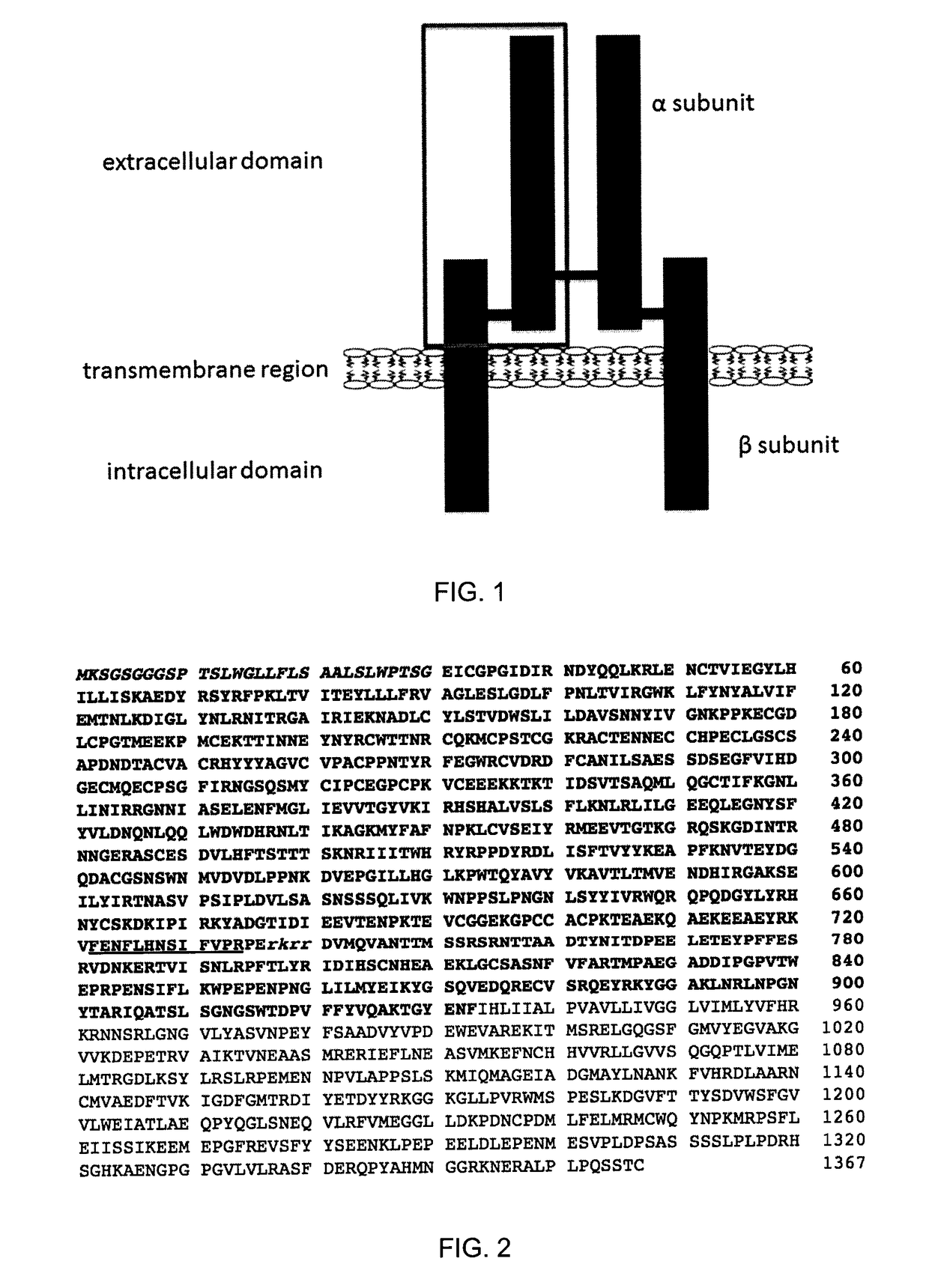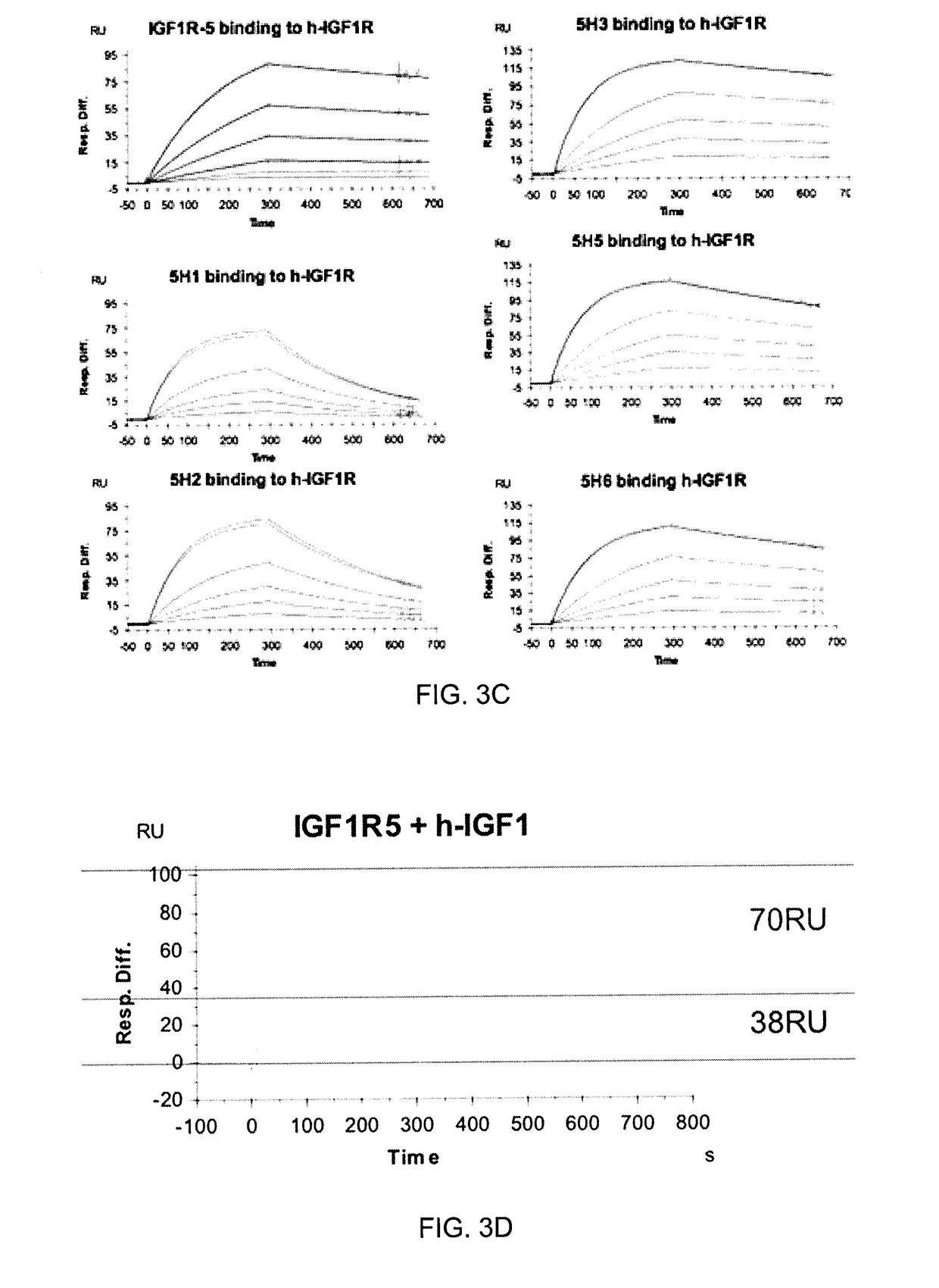Insulin-like growth factor 1 receptor-specific antibodies and uses thereof
a growth factor and receptor technology, applied in the field of insulin-like growth factor 1 receptor-specific antibodies, can solve the problems of tight junctions, difficult treatment and early diagnosis of alzheimer's and parkinson's disease, and an increasing burden on our ageing society, so as to improve the csf exposure, prolong the half-life of circulation, and improve the effect of cs
- Summary
- Abstract
- Description
- Claims
- Application Information
AI Technical Summary
Benefits of technology
Problems solved by technology
Method used
Image
Examples
example 1
Purification of IGF1R Recombinant Fragment
[0109]A 933 amino acid long recombinant fragment of the extracellular domain of IGF1R (shown by the grey box in FIG. 1; see also amino acids 1-933 of SEQ ID NO:14) was prepared. The fragment comprised an N-terminal 30 amino acid signal peptide, the full alpha subunit, a furin cleavage site (RKRR, SEQ ID NO:15; separating alpha and beta subunits), as well as the majority of the extracellular portion of the beta subunit (FIGS. 1 and 2).
[0110]Cloning. The sequence of the IGF1R ectodomain of interest was amplified by PCR using the following primers:
[0111]
5′-CGGGATCCGCCACCATGAAGTCTGGCTCCGGAG-3′(forward; SEQ ID NO: 16)5′-GCTCTAGATCAGAAGTTTTCATATCCTGTTTTGG-3′(reverse; SEQ ID NO: 17)
and subcloned into the SmaI site of Puc19. The IGF1R933 sequence was then sub-cloned into pCDN4 / myc-His (Invitrogen) to generate pIGF1R933-His, which allows for expression of a His-tagged ectodomain as described previously (Samani et al. 2004).
[0112]Transient Transfectio...
example 2
Llama Immunization and Serum Response
[0116]To isolate VHHs that targets the extracellular domain of IGF1R, a llama was immunized with the recombinant IGF1R933-His fragment obtained in Example 1.
[0117]One male llama (Lama glama) was immunized by sub-cutaneous, lower-back injection of IGF1R933-His recombinant antigen (Example 1). On day 1, 200 μg of antigen diluted in PBS to 1 ml was injected together with 1 ml of Freund's Complete Adjuvant (Sigma, St. Louis, Mo.). Three further injections of 100 μg of IGF1R933-His antigen plus Freund's Incomplete Adjuvant (Sigma) were performed on days 22, 36, and 50. A final injection of 100 μg of antigen with no adjuvant was performed on day 77. Pre-immune blood was drawn before the first injection on day 1 and served as a negative control. Blood (10-15 ml) was collected on days 29, 43, 57 and 84. The blood from day 84 was processed immediately to isolate peripheral blood mononuclear cells (PBMC). The blood was diluted 1:1 with phosphate buffered s...
example 3
Library Construction and Selection of IGF1R-Binding VHHs
[0119]A hyperimmunized llama VHH library was constructed based on RNA isolated from the PBMCs in Example 2.
[0120]Library construction and panning was performed essentially as previously described (Arbabi-Ghahroudi et al, 2009a, 2009b; Tanha et al, 2003). Total RNA was isolated from approximately 107 PBMCs collected on day 84 post-immunization (Example 2) using the QIAamp RNA Blood Mini Kit (Qiagen). About 5 μg of total RNA was used as template for first strand cDNA synthesis with oligo dT primers using the First-Strand cDNA Synthesis Kit (GE Healthcare). The cDNA was amplified by an equimolar mix of three variable region-specific sense primers:
[0121]
MJ1: (SEQ ID NO: 18)5′-GCCCAGCCGGCCATGGCCSMKGTGCAGCTGGTGGAKTCTGGGGG A-3′MJ2:(SEQ ID NO: 19)5′-GCCCAGCCGGCCATGGCCCAGGTAAAGCTGGAGGAGTCTGGGGG A-3′MJ3:(SEQ ID NO: 20)5′-GCCCAGCCGGCCATGGCCCAGGCTCAGGTACAGCTGGIGGAGTCT-3′,
and two antisense CH2-specific primers:
[0122]
CH2: (SEQ ID NO: 21)5′-C...
PUM
| Property | Measurement | Unit |
|---|---|---|
| molecular weight | aaaaa | aaaaa |
| molecular weight | aaaaa | aaaaa |
| Tm | aaaaa | aaaaa |
Abstract
Description
Claims
Application Information
 Login to View More
Login to View More - R&D
- Intellectual Property
- Life Sciences
- Materials
- Tech Scout
- Unparalleled Data Quality
- Higher Quality Content
- 60% Fewer Hallucinations
Browse by: Latest US Patents, China's latest patents, Technical Efficacy Thesaurus, Application Domain, Technology Topic, Popular Technical Reports.
© 2025 PatSnap. All rights reserved.Legal|Privacy policy|Modern Slavery Act Transparency Statement|Sitemap|About US| Contact US: help@patsnap.com



